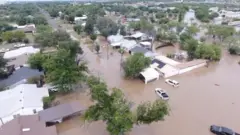Texas Floods: Examining the Early Warnings Amidst Devastating Deluge
Central Texas is reeling from the catastrophic impact of flash floods that have claimed the lives of nearly 80 individuals, with fears that the death toll may rise as rescue operations continue. The devastating deluge, which saw rivers like the Guadalupe surge by an astonishing 26 feet in under 45 minutes, has ignited critical questions surrounding the adequacy and timeliness of flood warnings issued to the affected communities. The sheer speed and ferocity of the event, which occurred over Thursday night and Friday morning, have left many searching for answers and grappling with the profound loss.
Kerr County bore the brunt of the tragedy, accounting for a significant number of fatalities, including 28 children. Local officials, including Kerr County Judge Rob Kelly, described the flooding as “unexpected,” stating they had “no reason to believe that this was gonna be any, anything like what’s happened here.” This sentiment highlights a perceived gap between the warnings issued and the reality on the ground, prompting a closer examination of preparedness measures.
Flood Warnings: What Was Issued and When?
The timeline of official warnings indicates that the Texas Division of Emergency Management (TDEM) had activated state emergency response resources on Wednesday due to “increased threats of flooding.” Subsequently, the National Weather Service (NWS) issued a flood watch for Kerr County on Thursday afternoon, identifying it as an area at high risk of overnight flash flooding. Critically, a flash flood warning for Kerr County was issued at 01:14 local time on Friday, with a more severe emergency flash flood warning following at 04:03 local time, and another for the Guadalupe River at 05:34. Despite these alerts, the catastrophic ইয়াহিয়া rise of the Guadalupe River suggests that the warnings, while issued, may not have translated into sufficient lead time for widespread, effective evacuation.
Examining Preparedness and Communication
Questions have been raised about the effectiveness of the warning systems in place. Kerrville City Manager Dalton Rice, in comments reported by the Associated Press, suggested that the public can become desensitized to frequent weather warnings. He also noted that a county-administered flood warning system, which could have provided an additional layer of alert similar to a tornado siren, was considered about six years ago but never implemented due to cost. This decision now comes under harsh scrutiny in the aftermath of the disaster.
The NWS, in defending its actions, stated it was “heartbroken by the tragic loss of life” and affirmed that its Austin/San Antonio office had issued timely forecasts and warnings. They reported providing preliminary lead times of over three hours before warning criteria were met for the July 3rd and early morning July 4th warnings. Experts also pushed back against suggestions that the NWS had underestimated the rainfall, with former officials telling The New York Times that the forecasts were as accurate as possible given the storm’s unprecedented intensity and rapid escalation.
Staffing and Budgetary Concerns
Amidst the tragedy, concerns have surfaced regarding the potential impact of budget cuts on the National Oceanic and Atmospheric Administration (NOAA) and the NWS. Reports have highlighted potential reductions in weather balloon observations, which are crucial for accurate forecasting, and critical vacant positions within the NWS. While some meteorologists expressed concern that staffing shortages could have hindered coordination with local emergency managers, the NWS Employees Organization has countered that weather forecasting offices (WFOs) were adequately staffed and resourced. Furthermore, the NWS office covering the affected central Texas region reportedly had an increased staff of five on duty, surpassing the usual complement of two, during the time of the storms.
Government Response and Future Preparedness
In the wake of the disaster, U.S. Homeland Security Secretary Kristi Noem addressed questions about the government’s role in providing early warnings. She acknowledged the inherent difficulty in predicting extreme weather but stressed the Trump administration’s commitment to modernizing and upgrading the technologies used for issuing warnings, which she described as having been “neglected for far too long.” Secretary Noem pledged to relay concerns about warning system improvements back to the federal government, emphasizing that upgrading technology is a priority. President Trump is reportedly planning a visit to the affected area, signaling a high-level focus on the disaster and its aftermath.

